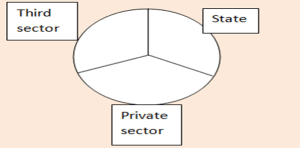Answer:
APPROACH AND STRUCTURE
1. Write an introduction.
2. Write some basics of good governance.
3. Explain bureaucratic nature of PA.
4. Show how GG sheds bureaucratic nature and implements democratic notions.
5. Give an alternative perspective.
6. Conclude.
INTRODUCTION: Good governance emerged in 1990s with an aim to democratize PA and make PA more citizen-centric in approach.
BODY: The World bank has defined ‘good governance’ as having six main characteristics( take help from governance question for important facts). These are:
-
- Voice and accountability that include civil liberties and political stability.
- Government effectiveness, which comprises the quality of policymaking and public service delivery.
- The quality of the regulatory framework.
- The rule of law which includes protection of property rights.
- Independence of judiciary.
- Curbs on corruption.
What is bureaucratic nature of PA?
Bureaucracy is known for:
-
- Hierarchy- flow of order from top to bottom
- Status quoist –resistant to change
- Rule driven-bound by standard operating procedure
- Formal and inward-looking
- Centralisation- concentration of power and authority
- Dominance-subjugates the citizens
- Institutional and mechanical
Good governance sheds power and leads to equal participation by every stakeholder i.e. public, private and third sector. State reduces its ambit of functions which is regarded as destatisation.
GG reduces the static nature of the administrative state and brings about dynamism through decentralisation, participation and consesus-oriented governance. It relegates the leviathan type of state and power is shared by all stakeholders.
How good governance democratises bureaucracy?
- GG imparts liberal democratic values not only in relation with citizens but also inside bureacracy. Internal relationship of bureacrats and citizens is also democratised.
- Now bureaucracy has to maintain transparency, accountability, responsibility and internal relationship among its members becomes becomes flatter in place of hierarchic, open in place of closed, progressive in place of status quoist.
- Relationship with citizens also gets transformed from client/constituent oriented to more citizen oriented.
- Citizens start playing key roles in governance. It is visible through various initiatives mooted by good governance like:
- RTI, Citizen’s charter, social audit,
- decentralization via 73rd& 74th CAA,
- SDGs, HDI, Corruption perception index
These try to democratise the bureaucracy by inculcating bottom-up approach instead of top-down one.

However, in actual practice the effects of good governance on bureaucracy have not been as desired. Authoritarianism is still prevalent. On the rule of law front, the scenario is not promising as:
1. There is arbitrariness in application of UAPA, NSA etc.The NCRB data 2020 shows the very poor conviction rate in UAPA cases.
2. State sponsored demolition is held to be violation of due process
3. Custodial deaths, corruptions, encounters, etc.
In other countries such problems also exist like:
-
- USA-the GFC and the subprime crisis, the large number of death during Covid, racism, poor response during cyclones etc.
- Europe: Eurozone crisis, racism,
- Srilankan- The political corruption and crisis.
- Africa-Military rule, terrorism, poverty etc
- Hence, we can say that even if GG has democratic values but still bureaucracy needs overhaul in terms of alignment between prescribed and practice.
CONCLUSION
OECD added another dimension of social justice while India calls it Sabka Saath, Sabka Vikas and Sabka Viswas as well as Minimum Government Maximum Governance. It means governance iss an evolving process so the democratisation of bureaucracy which is yet to happen at desirable level especially in developing countries.
Spread the Word
